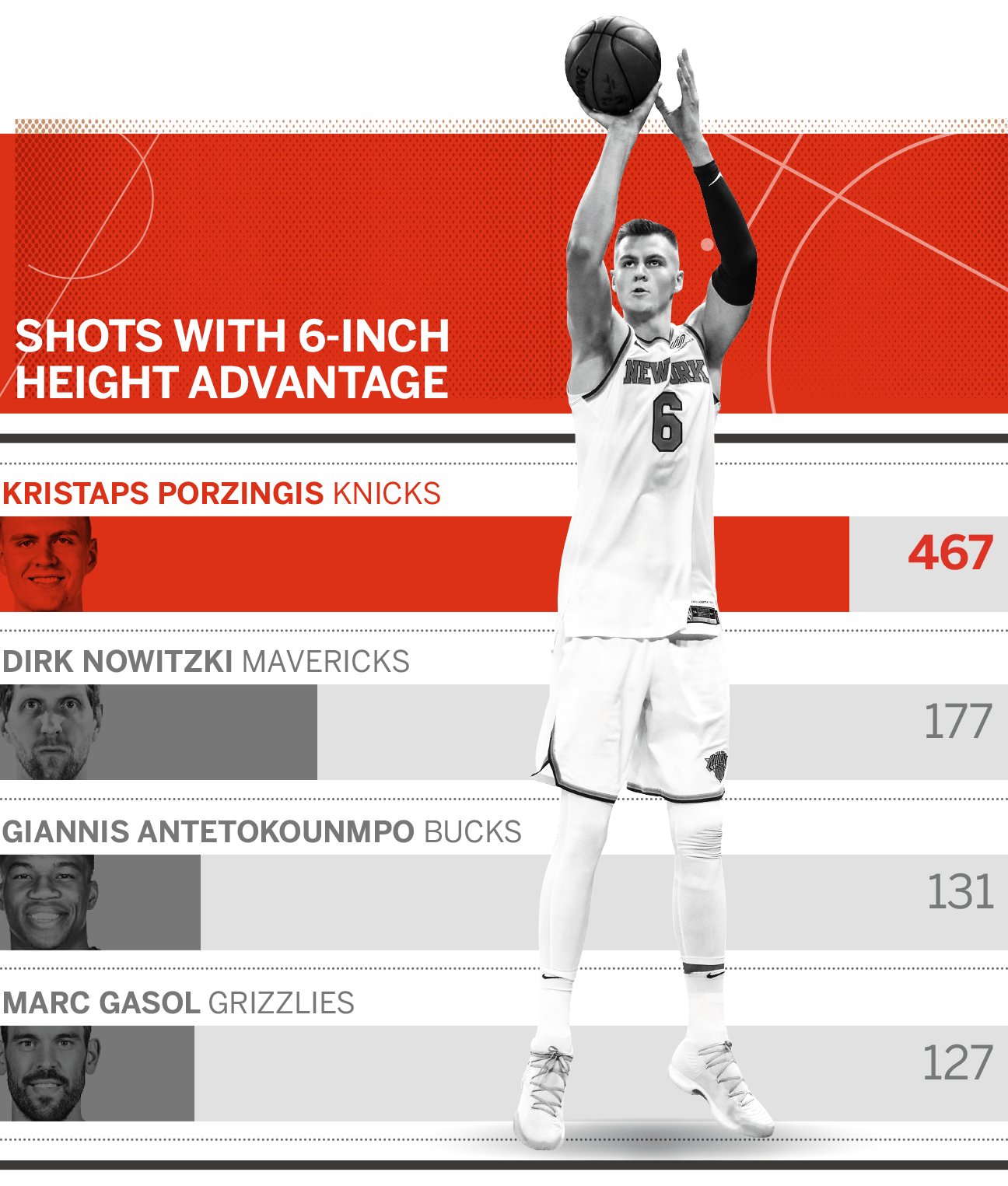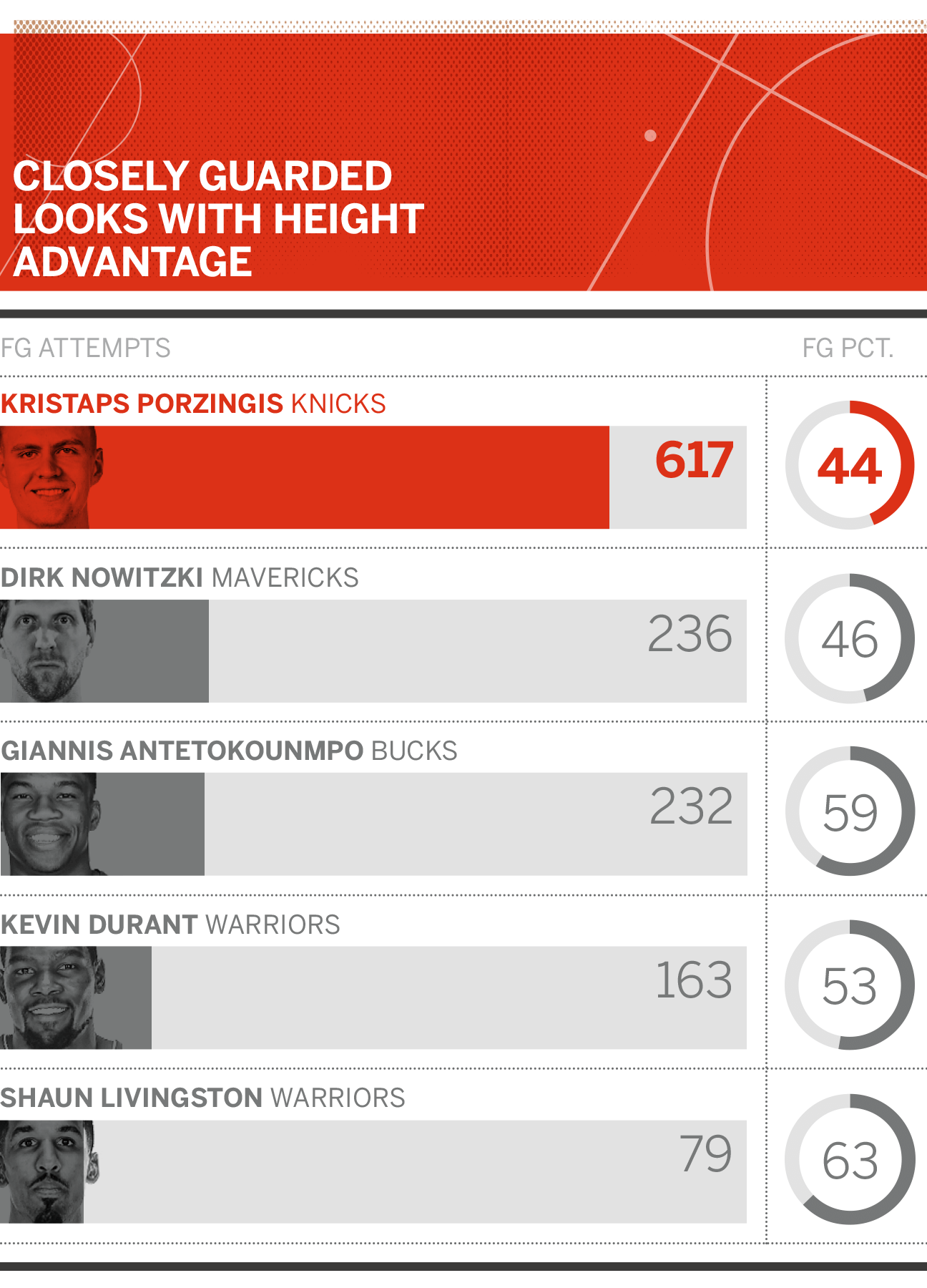Kristaps Porzingis owns an advantage that no other player in NBA history can match.
The idea of the unicorn is that it's something never seen before. It's a term that has entered the lexicon of casual NBA fans and been thrown around to describe not only Porzingis, but also Joel Embiid, Giannis Antetokounmpo, Anthony Davis and Kevin Durant. And yet the fact that Porzingis plays the style he does at 7-foot-3 makes him special even among the rarest of breeds.
We've seen players of his stature come along before, going all the way back to Swede Halbrook (the first NBA player to stand 7-3) and up to new LA Clippers center Boban Marjanovic (who shares with Porzingis the distinction of being the tallest active NBA player). The all-time club of NBA players who stand 7-3 or taller runs 25 deep.
But what does it really mean to stand at that height in a league trending small?
Let's begin with the basics. As the unquestioned top dog in New York, Porzingis is averaging a shade under 19 shot attempts per game for the Knicks, which would be the most ever by a player his size. In fact, prior to Porzingis, the only players 7-3 or taller to average 15 field goal attempts per game were Ralph Sampson and Yao Ming, skilled giants who would have no doubt developed killer outside strokes if they came into the league today.
Of course, standing tall has its advantages in shooting over defenders when stretching a defense. It's what gives Porzingis an edge over his supersized predecessors who didn't venture too far outside the forest. Sampson hit 17 percent of his 58 career 3s. Just 6 percent of Yao's total attempts came outside of 16 feet, according to Basketball-Reference.com.
No other player taller than 7-3 has ever averaged two or more 3-point attempts per game, something Porzingis has done in each of his three seasons. He's taking nearly three more 3s per game than the 1.9 by Arvydas Sabonis in 1996-97, the previous most by a player his size. Porzingis already has canned more 3s than every other player 7-3 or taller combined, surpassing that total in his 156th career game.
It's this combination of sheer size and high volume that creates the unique advantage shared by no other player in the league.

With player-tracking data courtesy of Second Spectrum, we know the height of every nearest defender on every shot taken leaguewide. Porzingis' considerable amount of time spent playing the 4, coupled with the switch-happy nature of today's downsizing league, creates mismatches on a scale that nobody else comes close to replicating. So far this season, he has taken nearly 300 more shots with a 6-inch height advantage over his nearest defender than Dirk Nowitzki, who has taken the second-most such attempts.
Simply by stepping on the floor and running basic actions, Porzingis spends more time being guarded by players a half-foot shorter than him than any other player. Clearly, this gives the Knicks' offense opportunities. And yet, as Chris Herring recently outlined for FiveThirtyEight, it hasn't translated into the types of high-quality shots you might expect.
This becomes particularly alarming when considering the pattern of Porzingis' shots after manufacturing significant mismatches. It all boils down to a single presiding factor: location, location, location, as shown here using Second Spectrum data.

Conventional wisdom suggests that when an offensively gifted big such as Porzingis generates a mismatch, it's time to go to work on the block. If the defense sends help, ball movement leads to a good look on the weak side. Leave KP in single coverage and it's game over.
Except that's not what happens. Look at every one of Porzingis' shots in which he held an advantage of at least 6 inches over a defender within 3 feet, and nearly 60 percent of them have come on either midrange or long 2s outside of 10 feet -- a shot he has connected on just 42 percent of the time, according to Second Spectrum. That equates to about 0.85 points per possession, which is a return on investment that would be significantly worse than the worst offenses in league history.
Here's Porzingis matched up just off the elbow against Kyle Kuzma, who is 6 inches shorter and 20 pounds lighter. This jumper is easy. It's always there.
He also doesn't need to take it so often.
With Porzingis using more shots than anyone on the roster -- a large percentage of which are contested midrange and long 2s -- it's probably no surprise then that New York on average take worse shots than any other team in the league. It's the same old story for the Knicks, who over the previous three seasons ranked at or near the bottom of the league in this same metric.
Porzingis is a phenomenal player, but these struggles in finishing over vertically challenged defenders in close proximity is nothing new, especially when compared to other players known for generating mismatches at their respective positions, according to Second Spectrum data.

The juxtaposition with a player such as Antetokounmpo is fascinating and also provides some insight into how Porzingis might better utilizing his unique advantage. Antetokounmpo is nowhere close to as good of an outside shooter as Porzingis. Instead, the Milwaukee Bucks forward feasts inside, leading the NBA with 16.6 points in the paint per game, according to NBA Advanced Stats. It's also why Antetokounmpo shoots 15 percentage points better than Porzingis when tightly guarded by a player 6 inches shorter.
Porzingis is nowhere to be found on the leaderboard for paint points per game, as he ranks outside the top 50. That's not particularly flattering for a No. 1 option who doubles as the highest volume player of his size in league history.
All of that aside, he's 22 years old and his future is beyond bright. Learning how to score when the whole defense is focused on you takes time.
"Five, six years down in his career, those probably won't be problems [against defensive pressure]," Knicks head coach Jeff Hornacek told ESPN.com's Ian Begley. "But right now, he's experiencing it, and he's going to learn from it."
And as Porzingis continues to get stronger and fill out, maybe we'll see him reverse the trend and start bulldozing helpless defenders down in the trenches or forcing them further out to 3 more often. But we're not there yet, and the Knicks All-Star knows it's a work in progress.
"I'm just trying to slow down mentally," Porzingis said earlier this month. "That's helping me. ... I'm not thinking I need to score as much. I just want to be involved. When the shots come, I'm going to take them, and they're going to be higher-percentage shots, not as many contested shots and not as much me fighting to get the bucket.
"I'm learning this year. I'm learning a lot."
